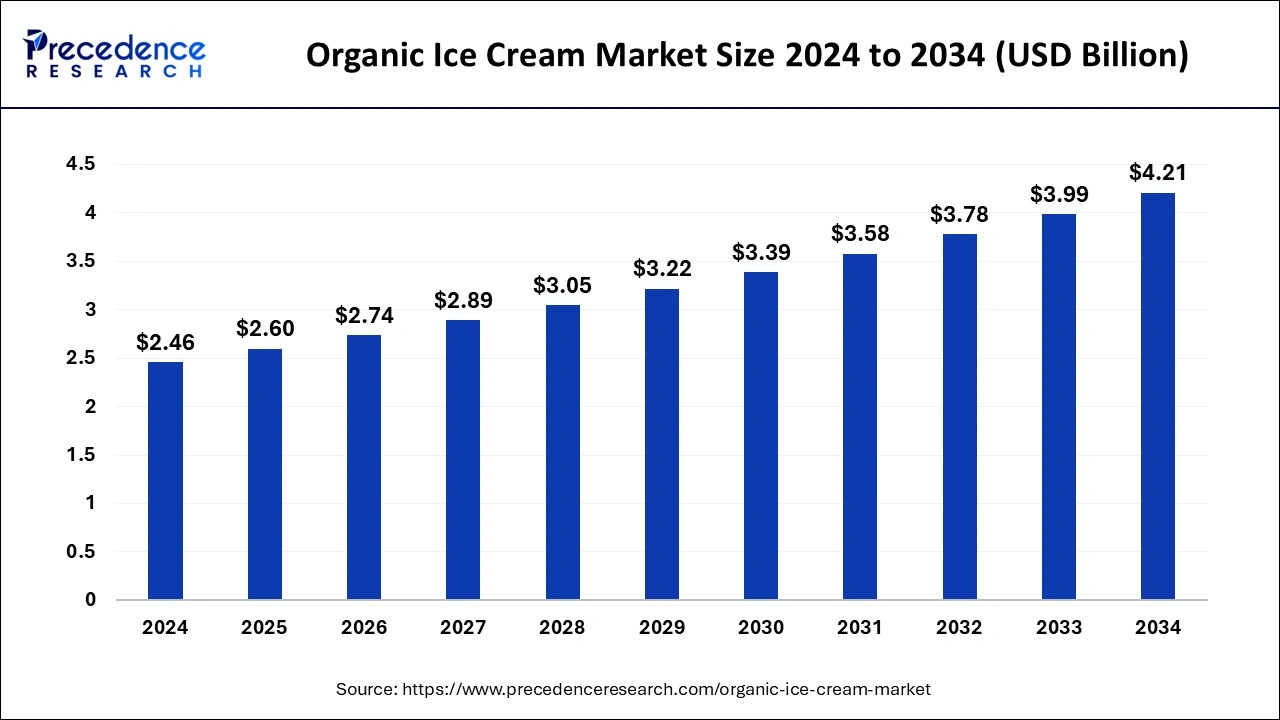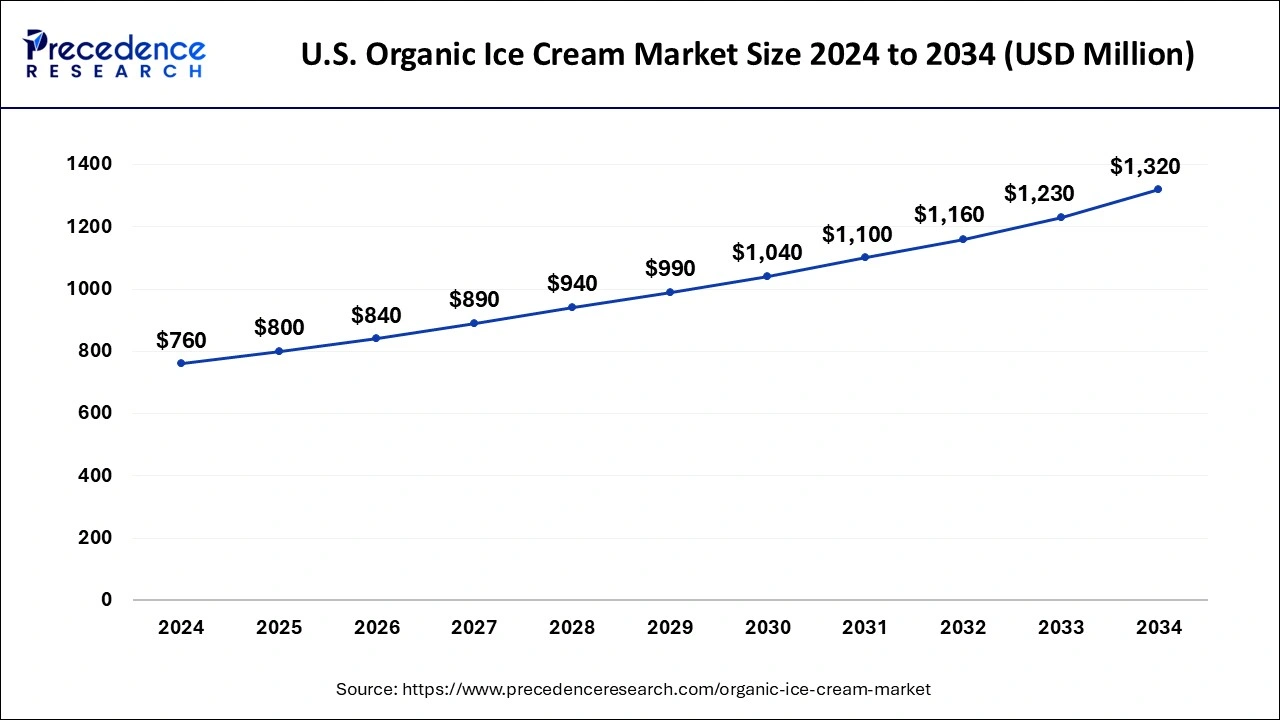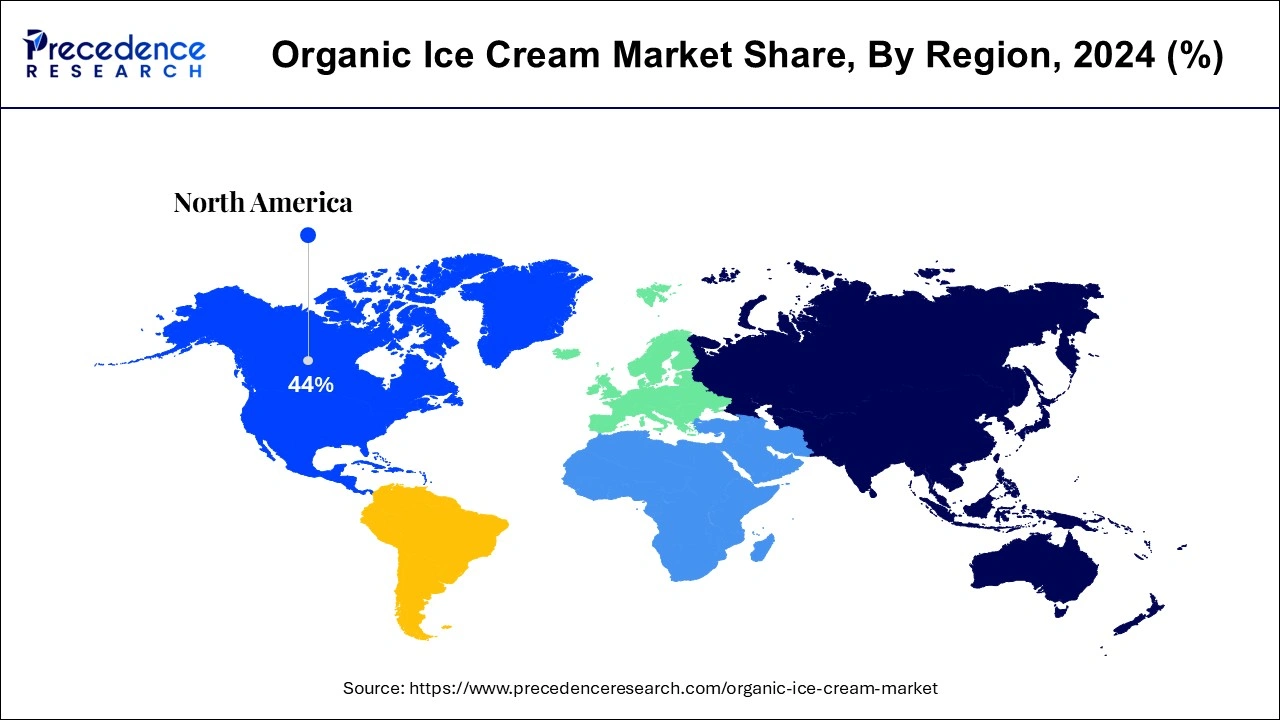January 2025
The global organic ice cream market size is calculated at USD 2.60 billion in 2025 and is forecasted to reach around USD 4.21 billion by 2034, accelerating at a CAGR of 5.52% from 2025 to 2034. The North America organic ice cream market size surpassed USD 1.08 billion in 2024 and is expanding at a CAGR of 5.64% during the forecast period. The market sizing and forecasts are revenue-based (USD Million/Billion), with 2024 as the base year.
The global organic ice cream market size was estimated at USD 2.46 billion in 2024 and is predicted to increase from USD 2.60 billion in 2025 to approximately USD 4.21 billion by 2034, expanding at a CAGR of 5.52% from 2025 to 2034. The organic ice cream market is driven by raising consumer awareness of health issues.

The U.S. organic ice cream market size was valued at USD 760 million in 2024 and is predicted to worth around USD 1320 million by 2034, expanding at a CAGR of 5.68% from 2025 to 2034.

North America has its largest revenue share of 44% in 2024 and is expected to dominate in the organic ice cream market throughout the predicted timeframe. This area is known for its innovative and entrepreneurial culture, especially in the food and beverage industry. Organic ice cream producers and manufacturers always develop new flavors, mixes, and package designs that cater to various consumer tastes and lifestyles. The emphasis on product development and differentiation propels the growth of regional markets and maintains consumer attention.
Customers are choosing more and more organic products over traditional ice cream due to growing worries about the health effects of artificial ingredients, preservatives, and additives. The area's demand for organic ice cream has increased due to increased health awareness.

Asia-Pacific is the fastest growing in the organic ice cream market during the forecast period. Policies have been put in place by a few governments in the Asia-Pacific area to encourage organic farming and the organic food sector. The manufacturing and consumption of organic ice cream have grown thanks to this support. The distribution network for organic goods, such as ice cream, has grown considerably in the Asia-Pacific region. A more comprehensive range of consumers can now quickly obtain organic ice cream because of its widespread availability at specialty health food stores, regular supermarkets, internet retailers, and even cafés and restaurants.
The organic ice cream market is the dairy industry segment that concentrates on generating cream from animals grown organically. Milk from cows, goats, or other animals farmed by organic farming practices is used to make organic cream. Generally, these guidelines forbid using artificial pesticides, antibiotics, fertilizers, hormones, and genetically modified organisms (GMOs) in livestock farming and feed.
It can be used as a topping for desserts, hot drinks like coffee or hot chocolate, and fruit salads. It can also be beaten into whipped cream. Organic cream is frequently added to coffee or tea to improve flavor and provide a creamy consistency. Creams with organic components can also be used in haircare products like masks and conditioners to hydrate and condition hair, making it manageable and smooth. Organic cream is utilized in formulating skincare products, including moisturizers, lotions, and creams, because of its moisturizing and emollient qualities. It aids in softening and nourishing the skin.
| Report Coverage | Details |
| Market Size in 2025 | USD 2.60 Billion |
| Market Size by 2034 | USD 4.21 Billion |
| Growth Rate from 2025 to 2034 | CAGR of 5.52% |
| Largest Market | North America |
| Base Year | 2024 |
| Forecast Period | 2025 to 2034 |
| Segments Covered | By Categories, By Ingredients, By Flavor, By Packaging Type, and By Distribution Channel |
| Regions Covered | North America, Europe, Asia-Pacific, Latin America, and Middle East & Africa |
Rising health consciousness
Customers concerned about their health are looking for products manufactured with natural or organic ingredients. Clean eating preferences are supported by organic ice cream, produced without artificial hormones, pesticides, or antibiotics. Because organic ice cream is made without synthetic ingredients, it appeals to customers who want to limit their exposure to chemicals that could harm them, such as pesticides. This is especially relevant to parents looking for healthier solutions for their families. Thereby, such rising health consciousness acts as a driver for the organic ice cream market.
Growing environmental concerns
Energy-efficient manufacturing, waste minimization, and appropriate packaging choices are eco-friendly activities that organic ice cream producers address throughout their production processes. Customers who care about the environment and want to buy things that reflect their values will find resonance in this. Many ice cream firms are switching to organic ingredients and eco-friendly procedures to meet consumer demands and lessen their environmental impact as businesses increasingly realize the value of sustainability and corporate social responsibility.
Limitation in market penetration due to low availability
Limitation in market penetration acts as a major restraint for the organic ice cream market. This restriction may result from insufficient production capacity, inadequate marketing efforts, logistical difficulties keeping freshness, or restricted distribution methods. In other words, organic ice cream's capacity to draw in and cater to a broader consumer base is hampered when it is challenging to locate in stores or is not well-visible in the market, which limits the product's ability to penetrate and grow in the market. Implementing efficient marketing techniques to improve consumer exposure and accessibility and the strategic expansion of distribution networks, production capacity, and supply chain efficiencies are necessary to overcome these availability constraints.
Availability of eco-friendly packaging materials
Delivering ice cream made with eco-friendly ingredients helps set a business apart from rivals in a crowded industry. Pledging to lessen their environmental effect and drawing in environmentally sensitive customers looking for sustainable solutions enables enterprises to distinguish out. Eco-friendly packaging aligns with the principles of organic customers, who highly emphasize environmental sensitivity and sustainability. Using ecologically friendly packaging improves the brand's reputation and increases customer loyalty among customers who care about the environment. Such emergence of eco-friendly packaging materials is observed to act as an opportunity for the organic ice cream market.
More and more customers believe that products with eco-friendly packaging are of superior quality and integrity. Organic ice cream companies can improve the consumer impression of their products by using sustainable packaging materials, accentuating the naturalness and purity of organic products.
The low-fat segment held the largest share of the organic ice cream market in 2024. Growing consumer health consciousness has been a significant factor in the growth of the organic ice cream market's low-fat sector. As customers become more conscious of the potential health hazards of high-fat diets, they actively search for healthier options that don't sacrifice flavor. Manufacturers spend time on research and development to produce low-fat ice cream recipes that deliver taste and texture without sacrificing quality. Thanks to developments in food science and technology, consumers can now enjoy low-fat organic ice creams with the same creamy mouthfeel as full-fat versions, meeting their expectations.
The benefits of organic agricultural practices for the environment and human health have raised consumer demand for organic products generally. Customers are choosing organic ice cream selections devoid of artificial ingredients, pesticides, and genetically modified organisms (GMOs) as part of this trend.
The whole milk segment dominated the organic ice cream market in 2024. Compared to skim or low-fat milk, whole milk has more fat. While some consumers might choose healthier options, many consider whole milk's higher fat content desirable when used in moderation because it gives the product a creamier texture and richer flavor. Furthermore, whole milk appeals to health-conscious consumers seeking a balance between enjoyment and nutrition because it provides essential minerals like calcium, vitamin D, and protein. It is well known for its rich flavor profile and creamy texture. It gives ice cream bases an opulent mouthfeel that entices customers looking for frozen delicacies to indulge in. Whole milk offers a more gratifying and luxurious taste than reduced-fat substitutes such as skim or almond milk.
The cream segment shows a significant growth in the organic ice cream market during the forecast period. Demand for organic ice cream prepared with premium, natural ingredients is rising as people become more aware of their ingredients and health. Customers who want a rich and decadent taste experience without sacrificing environmental or health concerns are especially drawn to the cream segment. Cream-based organic ice cream products are becoming more widely available in various retail settings, such as specialty shops, supermarkets, internet retailers, and even specialized organic food stores. The increased accessibility and ease of purchasing cream-based organic ice cream products due to this expanded availability propels market expansion.
The vanilla segment dominated the organic ice cream market in 2024. Vanilla is a flavor that appeals to various palates due to its pleasant scent and gentle sweetness. When it comes to organic products, consumers frequently identify Vanilla with simplicity and purity, which fits nicely with the trend toward natural, less processed meals. The vanilla bean, which comes from the vanilla orchid plant, is the source of Vanilla. Although organic vanilla beans may cost more than conventional ones, producers can now more easily obtain organic vanilla due to the growing availability of sustainable sourcing techniques and organic farming practices. Consequently, it is possible to create organic vanilla ice cream in large quantities without sacrificing its originality or quality.
Vanilla is a very adaptable taste that goes well with many toppings and ingredients. Because of its adaptability, a variety of flavor profiles can be created to suit consumers' varying trends and tastes. Vanilla is a mainstay in the organic ice cream industry since it can be combined in countless ways to create new flavors, whether mixed with chocolate, nuts, fruits or just eaten on its own. A major selling factor for organic products is frequently their purity. Vanilla personifies this idea of purity with its straightforward and organic flavor character. Because organic vanilla ice cream lacks artificial ingredients, preservatives, and flavors, consumers consider it a healthier option than traditional types. This idea fuels the market for organic ice cream by increasing demand for Vanilla.
The paperboard segment dominated the organic ice cream market in 2024. A notable change in consumer perceptions of sustainability and eco-friendliness has occurred recently. Therefore, packaging solutions with a low environmental impact are in greater demand. Paperboard packaging is highly recommended because it is biodegradable, recyclable, and sourced from renewable resources. The natural and rustic design of paper packaging complements organic ice cream's nutritious and organic attributes. The visual appeal of organic ice cream firms contributes to their entire branding and marketing, making them more noticeable on store shelves and drawing in customers.
Many organic ice cream companies have made environmental responsibility and sustainability core components of their business. These companies demonstrate their adherence to these principles by using paperboard packaging, which improves their brand recognition and attracts customers who care about the environment.
The flexible packaging segment is the fastest growing in the organic ice cream market during the forecast period. Flexible packaging is the best option for customers with hectic schedules or looking for on-the-go snacks since it provides unmatched portability and convenience. In keeping with the fast-paced nature of modern consumer culture, organic ice cream packaged in flexible pouches or bags facilitates easy access and effortless storage in freezers or refrigerators. These substances provide superior barrier qualities, shielding organic ice cream products from moisture, air exposure, and outside impurities. This satisfies customer expectations for quality and integrity by guaranteeing product freshness, extending shelf life, and maintaining food safety regulations.
The supermarkets & hypermarkets segment dominated the organic ice cream market in 2024. Supermarkets and hypermarkets provide customers with the ease of shopping in one location. A large selection of products is available, such as organic ice cream and other food items, so shoppers can conveniently buy all they need in one trip. A robust cold chain infrastructure is required to maintain the quality of ice cream goods, mainly organic varieties. Supermarkets and hypermarkets usually feature well-established refrigeration systems and logistics networks to guarantee that the products stay fresh from storage to display to purchase.
These big-box stores usually have a lot of shelf space, which enables them to carry a wide variety of goods, such as many brands and flavors of organic ice cream. This availability further boosts sales, which guarantees that customers have several options.
By Categories
By Ingredients
By Flavor
By Packaging Type
By Distribution Channel
By Geography
For inquiries regarding discounts, bulk purchases, or customization requests, please contact us at sales@precedenceresearch.com
No cookie-cutter, only authentic analysis – take the 1st step to become a Precedence Research client
January 2025
August 2024
October 2024
March 2025